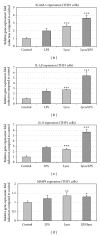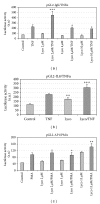Lycopene modulates THP1 and Caco2 cells inflammatory state through transcriptional and nontranscriptional processes
- PMID: 24891766
- PMCID: PMC4033542
- DOI: 10.1155/2014/507272
Lycopene modulates THP1 and Caco2 cells inflammatory state through transcriptional and nontranscriptional processes
Abstract
We revisited the action of a carotenoid, the lycopene, on the expression of proinflammatory genes, reactive oxygen species (ROS) production, and metalloprotease (MMP9) activity. THP1 and Caco2 cell lines were used as in vitro models for the two main cell types found in intestine tissue, that is, monocytes and epithelial cells. Proinflammatory condition was induced using either phorbol ester acetate (PMA), lipopolysaccharide (LPS) or tumor necrosis factor (TNF). In THP1 cells, short term pretreatment (2 h) with a low concentration (2 μM) of lycopene reinforce proinflammatory gene expression. The extent of the effect of lycopene is dependent on the proinflammtory stimulus (PMA, LPS or TNF) used. Lycopene enhanced MMP9 secretion via a c-AMP-dependent process, and reduced ROS production at higher concentrations than 2 μM. Cell culture media, conditioned by PMA-treated monocytes and then transferred on CaCo-2 epithelial cells, induced a proinflammatory state in these cells. The extent of this inflammatory effect was reduced when cells has been pretreated (12 h) with lycopene. At low concentration (2 μM or less), lycopene appeared to promote an inflammatory state not correlated with ROS modulation. At higher concentration (5 μM-20 μM), an anti-inflammatory effect takes place as a decrease of ROS production was detected. So, both concentration and time have to be considered in order to define the exact issue of the effect of carotenoids present in meals.
Figures







References
-
- Gerster H. Anticarcinogenic effect of common carotenoids. International Journal for Vitamin and Nutrition Research. 1993;63(2):93–121. - PubMed
-
- van Poppel G, Goldbohm RA. Epidemiologic evidence for β-carotene and cancer prevention. The American Journal of Clinical Nutrition. 1995;62(6, supplement):1393S–1402S. - PubMed
-
- ATCB. The effect of vitamin E and beta carotene on the incidence of lung cancer and other cancers in male smokers. The New England Journal of Medicine. 1994;330(15):1029–1035. - PubMed
-
- Canene-Adams K, Campbell JK, Zaripheh S, Jeffery EH, Erdman JW., Jr. The tomato as a functional food. Journal of Nutrition. 2005;135(5):1226–1230. - PubMed
-
- Levy J, Bosin E, Feldman B, et al. Lycopene is a more potent inhibitor of human cancer cell proliferation than either α-carotene or β-carotene. Nutrition and Cancer. 1995;24(3):257–266. - PubMed
Publication types
MeSH terms
Substances
LinkOut - more resources
Full Text Sources
Other Literature Sources
Medical
Miscellaneous

